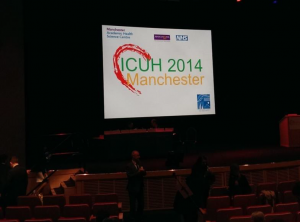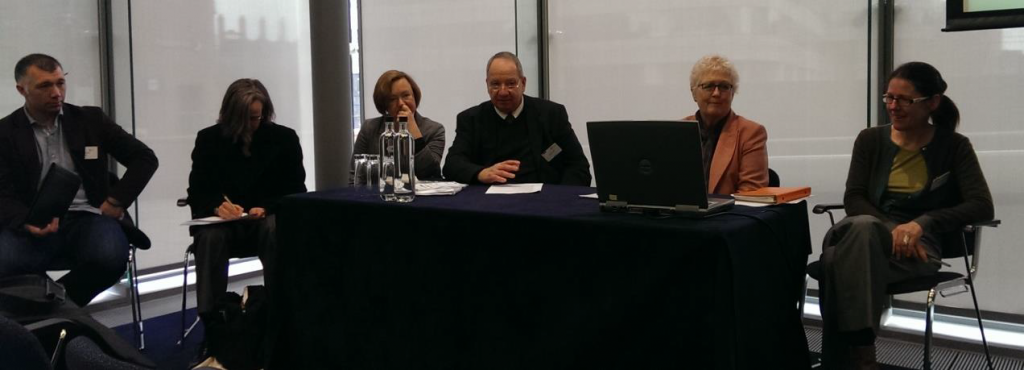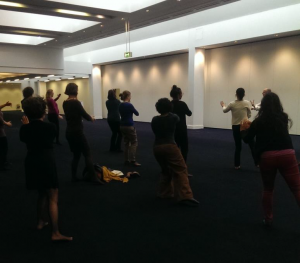International Conference on Urban Health 2014 – Day 1
Between 5 – 7 March, two integrated conferences are running that have been part organised by HCRI as part of the 11th International Conference on Urban Health – Global Health: 2015 and Beyond (organised by HCRI and Manchester Academic Health Science Centre) and Urban Risk and Humanitarian Response (organised by HCRI and the Global Urban Research Centre).
Covering the each day of these conferences are PhD candidates Cathy Wilcock, Jessica Roccard and Natalia Garcia Cervantes, who are live tweeting the conference via the HCRI Twitter feed and writing a blog entry to sum up each day – the first of which you can find below:
Welcome to Manchester! He who has health, has hope. He who has hope has everything (Martin Luther King)
The 11th International Conference on Urban Health opened this morning with a thought-provoking and dynamic opening ceremony. Welcome speeches from Professors Caiaffa, Vlahov, Jacobs, Sir Howard Bernstein and Andrew Gwynne MP all praised the city of  Manchesters pioneering role in public health, and referred to the legacy of the industrial revolution as a key factor in the citys present day public health issues. Keynotes speeches from Dr Howard Koh, Assistant Secretary for Health in the US, and Professor Sir Michael Marmot, both brought the social determinants of health into sharp focus.
Manchesters pioneering role in public health, and referred to the legacy of the industrial revolution as a key factor in the citys present day public health issues. Keynotes speeches from Dr Howard Koh, Assistant Secretary for Health in the US, and Professor Sir Michael Marmot, both brought the social determinants of health into sharp focus.
Risky business: Violence, fires and toilets
The HCRI/GURC opening plenary session for the sub-conference on Urban Risk and Humanitarian Response’ started with a presentation by Professor Moser on the inter-relations of urban violence and health. Human, financial and social capital are eroded by violence and this has a huge impact on individual health (both mental and physical) as well as on the general well-being of communities. Professor Moser suggests that, ideally, reducing violence should centre around six inter-sectoral approaches. Public health, she argues, should play a central role in this strategy. Does public health have the most effective preventative power in reducing violence? Is poor health best understood as a cause or effect of urban violence?
Next up was Steve Jordan from Greater Manchester Fire and Rescue Services and Operation Florian. He talked about his experiences of fire-fighting in Manchester and also of training brigades in different parts of the Global South. He has seen how fire can destroy lives and livelihoods because simple, inexpensive preventative and/or responsive measures have not been used in the cities of the Global South. He insisted that developing the institutional capacity of governments and communities, along with raising awareness, and conducting more research should be the main targets for improving fire safety across the board. This interesting presentation poses the question of the role of governments in the implementation of emergency response to disasters such as fires.
Barbara Evans from University of Leeds and Chair of UN Joint Monitoring Programmes on Sanitation brought her experience of water/sanitation projects to the table. In spite of the obvious consequences (1.7 million die from diarrhoeal disease per year) in many urban environments, she has observed a systematic failure around water and sanitation. Infrastructure is completely lacking, as is human capacity in many places. Demotivation among the government actors to address the underlying issues stems from a sense of overwhelming futility in the face of such huge problems: they often only act in periods of health crisis. Her talk reiterates the question raised in the previous presentation: What is the role of governance institutions in water and sanitation responses? How can the issues of water and sanitation be tackled in those cities with little or no infrastructural planning?
Safety first?: Roads and fires in the Global South
After lunch, Emma Maclennan, Eastern Alliance for Safe and Sustainable Transport presented on the health impacts of global road safety in the first of the ‘Stress in the City sessions. Her organisation focuses on building local capacity and expertise. 1.3 million are killed annually in RTAs (road traffic accidents) and 90% occur in low and middle countries. RTAs cost an average 1-3% of GDP and they are a major drain on health insurance costs. Safer vehicles, road-users, roads and post-crash responses, as well as building capacity are five key action points for making roads safer.  The statistics she presented demonstrate the extent of the issue: RTAs actually kill almost as many persons as the diarrhoeal diseases stated previously.
Following on from Emma, three members of the Fire Service recounted their experiences of working in non-UK contexts. Together they demonstrate how the Fire Service can provide assistance in areas of prevention, response, and research-based strategy. Keith Trotter of Tyne and Wear Fire and Rescue presented about a community safety project in Mitjana, Uganda which aims to educate on fire safety in schools in Uganda where many people use candles in their homes in the absence of electricity. Following this, Neil Pickersgill of Greater Manchester Fire and Rescue Service spoke about his experience of responding to the Japan tsunami. His team had to adapt their strategy because they were not prepared for the fact that their work involved recovering bodies, rather than rescuing people. George Bryant from Gloucestershire Fire Service worked on permanent refugee camps in Kenya. They conducted participatory research in the camp to identify hazards and also to identify the most at risk demographic. They then devised fire safety strategies based on their findings and attempted to oversee their local implementation in the face of the Government reluctance for them the camps are transitional and non-permanent (even though they are, for all purposes, permanent). These presentations demonstrated the various skills these units have to acquire to be efficient in Steven Jordan’s words, the fire service is not just about sitting and waiting for a bell to ring! From prevention strategy, to research, to education and training, to liaising with policy-makers, as well as emergency responses, these various lines of work must be able to adapt to different situations and cultures. Plus, again, the role/responsibility of governance came through strongly.
Afternoon tensions: displacement and knowledge production
In the first of the Ambivalence of humanitarianism sessions, Mateja Celestina and Professor Bertrand Taithe discussed different aspects of displacement. Mateja Celestina was presenting findings from her PhD fieldwork in Colombia. She raised issues around the sense of belonging which she has observed being constructed by IDPs in relation to both (or, in some cases, neither) their new place of residence and their place of origin. Also, a key finding of hers was that the ways in which the IDPs and the non-displaced population related to each other (for example as competitors for land and resources) affected the IDPs sense of belonging. Integration is clearly an issue here how can the re-location of people be implemented with minimum disruption to both the host community and the displaced? Are economic and cultural tensions between displaced and native groups inevitable or preventable in the process of displacement?
Professor Taithe then provided a rich analysis of the conditions in the refugee camps in Thailand housing Cambodian refugees from 1975-1996. Given that the camps provided good experimental conditions for longitudinal research on trauma and other health issues, Professor Taithe shows how the camps became epistemic communities where scientific knowledge was being produced.
And breathe
After a full day of presentations and discussion, Tai Chi in the foyer.




0 Comments